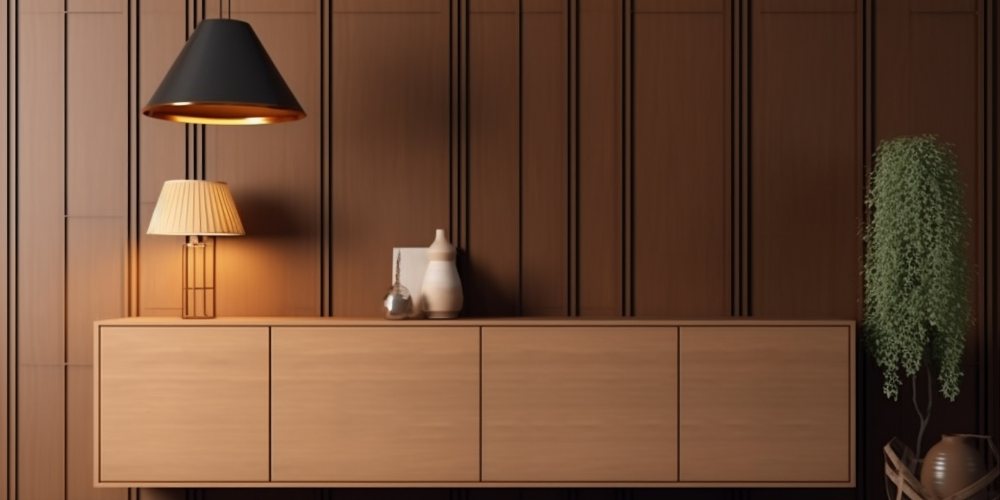You must be careful when ordering one, as it is a very important part of your kitchen!
Thinking “how do I choose a good kitchen cabinet”?
Wondering what questions to ask when ordering a cabinet for your kitchen?
Looking for some help planning your kitchen cabinet design?
Then read this blog post – we will reveal the crucial details you should be aware of when making your choice!
The top things to know when ordering a kitchen cabinet
Many of your kitchen’s essential items – from goods like dishes and utensils to additives/condiments like salt and turmeric, and even dry food items like certain vegetables and instant food packets – will be stored in the cabinets.
Which means that they will take up a lot of space on your walls, and could end up becoming a focal point of your kitchen.
In our experience as interior designers in Bangladesh, we have seen that no matter what shape or layout your kitchen follows, the cabinetry always becomes one of the most important aspects of its interior design.
To get the best fit for your kitchen, read through this post to make sure you have the information you need!
Stock and custom cabinets
Based on how they’re manufactured and sold, there are two basic types of cabinets – stock cabinets and custom cabinets.
Stock cabinets
These are the cabinets you can see at any furniture or home improvement shop.
They will be fully manufactured and you can purchase them straight away (or have them delivered).
Once they arrive at your home, it will be very easy to install them in your kitchen – you can DIY, or maybe the company will send a workman to do it for you.
Of course, as these are mass-produced, there is a limited choice of materials, style and colours that you can choose from.
On the other hand, the price will probably be on the lower side which makes them suitable if you are doing a budget renovation of your kitchen.
Custom cabinets
A custom cabinet is one that is built exclusively for you by a furniture maker.
They are made to accommodate your specific needs – whether it be a particular style of design like leaded-glass doors or addition of unique features, like a coffee station.
Even the size – you can ask for it to be like the typical modular cabinet or a ceiling-to-floor piece.
In custom cabinet design, everything from basic configuration and frame to colours and finish will be done as per your requirements. A good cabinet maker should discuss all of these with you.
As a cabinet can end up becoming an accent piece, you may want it to have an irregular appearance – this is something a stock cabinet can never deliver.
As you can expect, given how much time and effort it will take to produce a custom cabinet, it will cost more than a stock cabinet.
Custom cabinets are the preferred choice in upscale kitchen renovation projects.
Want to design a custom cabinet for your own kitchen? Talk with our furniture team today!
Semi-custom cabinets
This is a third cabinet category which is offered by some furniture makers and companies.
As you can guess, this comes midway between a custom cabinet and a stock cabinet.
In other words, the framework of the cabinet will be preset, but you can decide some of the features such as how large the drawers will be, what the colour on the external walls will be and so on.
Types of cabinets
Depending on where you want to place them, and what your main use for them will be, kitchen cabinets can be divided into various types.
- A base cabinet is found below work surfaces like countertops and apart from storing things they support the work surface. They’re usually of standing height.
- As the name suggests, a corner cabinet will be specially designed to make the best possible use of space at kitchen corners.
- Wall cabinets can be made of various widths and heights. For example, shorter wall cabinets can accommodate a microwave underneath them while a taller one will offer more storage space.
- Pantry cabinets usually remain on the floor and prioritise making use of vertical space. They will have two doors and two or more adjustable shelves.
Framed and frameless cabinets
A framed cabinet will have a structure on the front of the cabinet box that adds strength and stability.
The frame can go out around 2 inches past the cabinet opening.
As the frame adds strength to the structure, a framed cabinet can be not so thick and can fit into a narrower space.
Note: This is a typical American cabinet style.
In a frameless cabinet, the cabinet box will be thicker and the doors and drawers will directly attach to it.
As it’s frameless, you gain access to a greater amount of space inside.
Note: This is typical of European-style cabinetry.
Here are some features of a good kitchen cabinet you should know.
Various kitchen cabinet materials
Like with any bit of furniture, the cabinets in your kitchen can be made of various materials.
Let’s take a look at some of the most important ones.
Solid wood
If you ask any premium room designer, they will mention solid wood as their preferred option for an upscale kitchen renovation or remodel.
Why?
Because solid wood has a unique look and feel that cannot be replicated with any other material.
And while its look is implicitly vintage, it can be adapted – with skilful cabinet making – to even a modern kitchen design.
Note: Solid wood can be vulnerable to water damage and insect infestation, for which you will have to take steps.
Stainless steel
Stainless steel is one of the best materials for a humid climate like Bangladesh’s. Also, it’s durable and eco-friendly.
With the right manufacturing and finishing, a steel cabinet can get a really upscale look.
Stains and insects should not be a problem.
One complaint with stainless steel is that it shows fingerprints and scratches easily but that can be removed with widely available cleaners.
Particleboard
From a price point of view, particle board cabinets are a good choice.
Structurally, it can be a good material for frameless cabinets (as it can hold door hinges and screws in place).
However, particleboard can expand and distort in shape from moisture. It can also lose colour.
You will need sealers and paint to resolve those problems.
Plywood
“Ply” is a preferred choice for a lot of designers and customers of kitchen interior design.
It is a reasonably budget-friendly material.
It weighs less than particleboard and can be a good choice for wall cabinets.
Like particleboard, it can be good at holding nails and screws in place.
And unlike particleboard, it is not so vulnerable to expansion and bending.
Finally, ply has a lower shelf life than solid wood.
Note: If you do go for plywood, make sure you ask for waterproof ply.
Medium Density Fibreboard
Medium Density Fibreboard (MDF) is a composite material made of recycled wood and resin.
You can think of it as “engineered wood”.
The big advantage MDF has is that it’s resistant to cracking and peeling.
It is smoother than plywood and can be customised easily as well.
Note: Scratches can be difficult to repair and they can get damaged in high temperatures.
Want to learn more about which materials would be the most effective for your kitchen requirements? Schedule a consultation with us!
Taking cabinet measurements
Picture this: You work with a designer to create a cabinet exactly as you want, they bring the cabinet to your kitchen…and then you find there isn’t enough space for the drawers to open fully.
Problems like these can spoil your entire investment into kitchen cabinet design.
Which is why we’re discussing how to get accurate cabinet measurements here.
A good custom furniture maker will send a professional to your house and take all the necessary measurements; so you don’t need to worry.
If you go for stock cabinets, the shop or company may send someone to take measurements; that entirely depends on their policies.
When planning your kitchen renovation, take measurements of the kitchen’s dimensions, wall lengths, ceiling height, and the location of appliances, plumbing, and electrical outlets.
Use this information to consider what size and style of cabinets would work best in your space. Also, consider any current problems with your cabinets and think of other kitchens for inspiration.
Finishing and colours
You know how important the colours are in any room design and furniture making.
Now, while the exact colour and finishing will depend on your personal preference, allow us to give you a basic idea of the three basic types of colours and finishes you can choose from.
Unfinished cabinets
Unfinished cabinets are not painted, stained or varnished. They give a casual and rustic look to the kitchen, especially when they are made of natural woods like mahogany.
Stained cabinets
Stained cabinets are a common option for kitchen design. The stain is used to enhance the wood grain or change its colour by applying it either by hand or with a spray.
A sprayed-on stain provides a more consistent finish, while hand-applied stains create a varied and unique look.
Painted cabinets
Painted cabinets can be customised to match your kitchen design, but they require more maintenance than other options. Semi-gloss, gloss or satin finish paint are practical choices for kitchen cabinets because they are easier to clean and more stain-resistant than matte finish.
Some tips for budgeting
The first thing to consider is the purpose of the renovation.
If you are thinking of offering the house on rent, or selling it, set a lower budget.
That’s because in our experience, a kitchen remodel does not add a lot of value for the typical buyer.
On the other hand, if you’re remodelling to create a cooking space for yourself, go all out in creating an upscale look.
Next, take measurements. Check how much space you want the cabinetry to occupy.
Remember to do it for both upper and lower cabinets.
Remember, the cabinets can take up as much as 40% of your total remodelling budget.
Changing the depth of the cabinet, adding utilities like breadboards, or going for features like lead-glass doors will add to the cost.
These are personal touches that can add up to 20% to your basic cabinet bill.
Some questions to ask
- What is the material of the overall box?
- Does the cabinet door open easily?
- Is there space for the door to swing open fully?
- Are hinges adjustable?
- Are the shelves strong?
- Do the drawers slide smoothly?
- Are there joints holding the drawer together?
- Is the bottom of the drawer fitted into grooves?
What to know and ask before you place a kitchen cabinet order – key takeaways
To summarise, before you place an order for a cabinet/cabinets for your kitchen you should be aware of some basic points like:
- The difference between stock, custom and semi-custom cabinets
- Types of cabinets – base/floor, wall, and pantry.
- What are framed and frameless cabinets?
- Features of various cabinet materials.
- How to take the important measurements.
- The various kinds of finishing and colours you can choose from…and…
- How to budget.
As the cabinet can end up becoming a very significant part (accent piece) of your kitchen, you should read this blog before deciding what to order.
All the best with your kitchen renovation!











